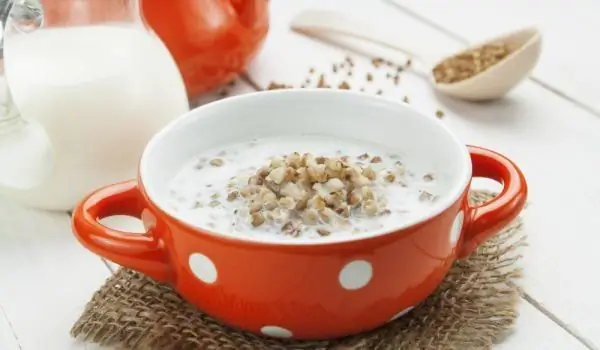2025 Author: Jasmine Walkman | [email protected]. Last modified: 2025-01-23 10:18
Buckwheat is not a cereal, although it is often prepared as such. In our country, buckwheat has gained great popularity in recent years, and although it was once used mainly as food for the common people, today even the best restaurants in the world necessarily offer specialties with the addition of buckwheat.
In fact, buckwheat (Fagopyrum) is a genus of angiosperms of the Lapad family (Polygonaceae). There are several types of buckwheat: perennial buckwheat (Fagopyrum cymosum), common buckwheat (Fagopyrum esculentum) and Tatar buckwheat (Fagopyrum tartaricum). The ordinary buckwheat is also popular as buckwheat, which is the Russian name for these delicious useful triangular berries. India is considered the homeland of buckwheat, but its popularity is greatest in Russia.
Origin of buckwheat
There is evidence that buckwheat was grown 6,000 years ago in Southeast Asia. The origin of the culture is associated with the lands of the Altai, and around 7-8 century from the territories of present-day Romania buckwheat enters and spreads in Russia. In Europe, the grains arrive much later - between the 15th and 18th centuries. In India, buckwheat is called "black rice", and in other countries it is known as "black wheat". In Greece and Italy it is called "Turkish grain", and in France, Spain and Portugal it is known as "Saracen" or "Arab grain". In other Slavic countries, buckwheat is called Greek grain because it was grown centuries ago by the more competent Greek monks in the monasteries in the territories inhabited by Slavic peoples. The Latin name of buckwheat (Fagopyrum) comes from the fact that its grains resemble a beech nut, which is why it is often called beech wheat.

With the mass distribution of buckwheat, it quickly became a regular guest at the tables of poorer people. Buckwheat is easy to grow, and its crops do not grow weeds naturally, which does not require treatment of crops with chemicals. Chemicals radically change the taste of the grain, which is a prerequisite for the crop to be environmentally friendly food that is used to feed infants.
Composition of buckwheat
Triangular buckwheat grains contain up to 16% easily digestible proteins, including the useful essential amino acids arginine and lysine. Buckwheat contains 30% carbohydrates, 3% fat, fiber, malic, citric and oxalic acid, vitamins: B, B1, B2, PP (rutin), P, E and minerals: iron, calcium, magnesium, potassium, phosphorus, copper, zinc, boron, iodine, nickel, cobalt.
Selection and storage of buckwheat
In our country you can find buckwheat at an affordable price, most often in packages of 500 g in almost all major food chains. Buckwheat packages are often on diet stands, and there is no Russian store that does not offer the product.
Here are some tips to keep in mind when choosing buckwheat. When choosing buckwheat, pay attention to the following features

- Choose buckwheat with a pale color, because the one with a reddish tinge in most cases has undergone heat treatment, as a result of which much of its nutrients are wasted;
- Once you open the package with buckwheat you feel an unusual smell of mold, this means that the product is spoiled or of rather poor quality and it is better not to consume;
- Always store buckwheat in glass or ceramic containers.
Buckwheat in cooking
Buckwheat is gaining more and more culinary application and popularity. Although it has a slight astringent-bitter taste, it is used successfully in both salty and sweet recipes. "Black wheat" is well known to many people who practice vegetarianism because it is a complete substitute for meat. Buckwheat is used in baby foods. For centuries, it has been used to make easily nutritious porridges.
Buckwheat is used with great success for the preparation of salty and sweet dishes. In addition to porridge, buckwheat can be prepared as an addition to meat dishes, vegetables, even fish and soups. Buckwheat desserts are often prepared in combination with fruit or put in fruit. With buckwheat flour you can prepare various cakes or pancakes, or add it to the dish to thicken if necessary. Buckwheat can also be prepared as rice, as the amount of product: water is 1: 2. If you are making soup, add the buckwheat almost at the end so that it does not overcook. You can add buckwheat in pate, various stews, casseroles, sarma with meat or vegetarian.

Put the buckwheat to boil for 4-5 minutes, then wash in a colander under running cold water and drain. Another option is to pour a bowl of hot water over the buckwheat, cover and wrap the dish in a large towel to suffocate well. So it should be aged for a day, and the next morning you can prepare it as a breakfast, like muesli, or use it as a salad side dish - both with fruits and vegetables.
Benefits of buckwheat
Buckwheat is called a "berry for millions", not only because it is rich in vitamins and minerals, but because it is a suitable food for all ages, brings many benefits to the body, and is suitable for active athletes and those of us who are on a diet..
Compared to potatoes and other cereals, buckwheat is the poorest in carbohydrates, which makes it an excellent food for diabetics, as well as for those who are obese and overweight. Buckwheat porridge is recommended for cardiovascular and liver diseases. The beneficial substances of buckwheat help to remove cholesterol from the blood, as well as heavy metal ions. It is a recommended food for and against varicose veins and hemorrhoids.

The nutrients contained in it reduce the permeability of the walls of blood vessels and their fragility.
Experts recommend regular consumption of buckwheat and rheumatism and arthritis, against atherosclerosis, hypertension, hypothyroidism to improve blood circulation, the immune system and to maintain good vision.
Nutritionists are adamant that buckwheat porridge with milk provides the most optimal ratio of protein, fat and carbohydrates in the body. The opinion comes after an experiment during which volunteers ate porridge for 6 months buckwheat and a few apples every day. At the end of the term it was found that the working capacity of the volunteers is increased and their physiological indicators are much better compared to those of the control group.
As mentioned, buckwheat can be a partial substitute for meat because it contains large amounts of iron. This in turn makes it suitable for consumption in anemic conditions. For higher levels of hemoglobin in the blood, only 2 tablespoons of buckwheat flour a day are enough. The flour should be pale in color, from unprocessed and unbaked buckwheat.
Buckwheat is used even in reflexology. Walking barefoot on buckwheat grains is often practiced, the shape of which allows the active points of the foot to be pressed. If you want to relax and massage your tired hands, put a few nipples between your palms and rub them. This will achieve a noticeable toning and relaxation.
Even buckwheat flowers have healing properties. The decoction prepared by them has a proven expectorant effect.
Harm from buckwheat

The only adverse effects of eating buckwheat can be if you overeat or if you are allergic.
Buckwheat diet
The beneficial properties of buckwheat are harnessed in many diets, thanks to which you effectively lose weight and cleanse the body. One of the most common diets with buckwheat can lose up to 10 kg per week. It belongs to the so-called drastic diets, but in most cases the result is worth it.
During the diet, you only need to eat buckwheat steamed overnight for a week, as we explained in the culinary application of buckwheat.
The only thing you can afford besides the diet prepared in this way is up to 1 liter of low-fat milk kefir per day. If desired, you can repeat the one-week regimen with buckwheat, but after 1 month. After the end of the diet, a smooth diet with an initial low-calorie intake per day is needed.
Recommended:
Tips For Cooking Buckwheat

Increasingly, we find recipes prepared with such useful buckwheat, or the so-called. buckwheat. Here in a concise style, short, precise and clear, I will present you some highlights in the preparation of buckwheat in cooking. If the dish is intended for baby food, do not add salt, and when it is for adults, salt is added to taste in the water in which it will boil.
Efficient And Easy Diets With Buckwheat

The buckwheat diet is one of the ways to achieve a slim figure and is absolutely safe for your health, you just should not follow it for too long. Buckwheat is rich in many substances that are necessary for the normal functioning of the body.
What To Cook With Buckwheat Flour

The beneficial properties of buckwheat flour are mainly associated with its rich content of iron, calcium, potassium, phosphorus, iodine, zinc, magnesium, manganese, fiber and amino acids. Buckwheat flour is still not a commonly used product in our country, unlike in Russia.
How To Properly Prepare Buckwheat?

Buckwheat, which has been talked about more and more in the last decade, continues to gain more and more popularity. There is nothing strange in this, as it is a real bomb of invaluable ingredients. It contains more protein than meat and meat products, many vitamins and minerals, while being extremely low in fat.
Healing Diet With Buckwheat And Kefir To Restart The Body

This diet restores the balance of trace elements in the body, helps with stress, insomnia, fatigue. Recommended for anemia, skin problems, joints, liver and gallbladder diseases. Buckwheat is an energy-intensive product, contains more protein and much less carbohydrates than other cereals.

